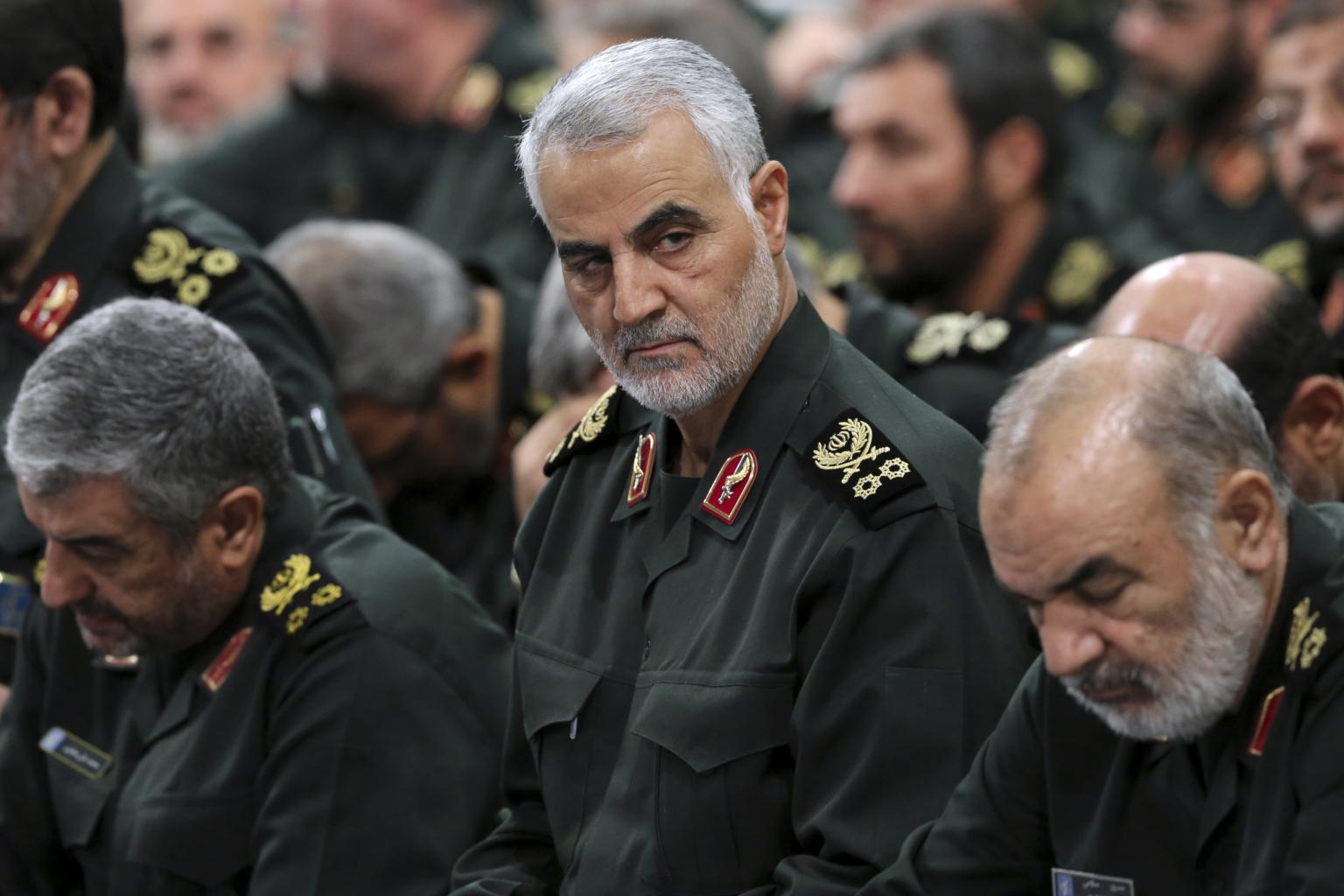Oil and gold spike, US dollar stumbles after US air strike kills top Iranian commander in Iraq
Sign up now: Get ST's newsletters delivered to your inbox

A photo from Sept 18, 2016, shows Iranian general Qassem Soleimani (centre) who was killed in a US strike near Baghdad international airport.
PHOTO: AP
Follow topic:
SINGAPORE (BLOOMBERG, REUTERS) - Oil and gold jumped and the US dollar stumbled after a US airstrike ordered by President Donald Trump killed a top Iranian general in Iraq, intensifying fears of conflict in the world's most important crude-producing region.
In a turbulent start to the Asian day marked by unusually heavy trading, futures in London and New York surged by more than 4 per cent to levels not seen since the attacks on Saudi Arabia's infrastructure in September, 2019. The strike near Baghdad airport killed Qassem Soleimani, the Iranian general who led the Revolutionary Guards' Quds force, according to a Defence Department statement.
While no oil installations or production were impacted, the killing of one of Iran's most powerful generals is a provocation that ratchets up tension between Washington and Teheran, heightening fears of an armed confrontation that could pull in other countries. As focus shifts to how Iran will react, the country's supreme leader, Ayatollah Ali Khamenei, vowed that "severe retaliation" awaits the killers of Soleimani, according to a statement.
"This is more than just bloodying Iran's nose," Mr Stephen Innes, chief market strategist at AxiTrader Ltd said in a note. "This is an aggressive show of force and an outright provocation that could trigger another Middle East war."
Crude prices had pared back some of their immediate gains by midday in Singapore but remained at the highest levels since September. London's Brent crude for March settlement was up US$2.12, or 3.2 per cent, at US$68.37 a barrel on the ICE Futures Europe exchange at 1:25pm Singapore time. It earlier jumped as much as 4.4 per cent to US$69.16 a barrel.
In New York, West Texas Intermediate for February delivery was 3.1 per cent higher at US$63.07 a barrel. The contract earlier advanced as much as 4.4 per cent to US$63.84, exceeding September's levels to the highest since May. Total aggregate volume for Brent and WTI was about 20 times the 30-day average.
Tensions have been building between Washington and Teheran after an Iran-backed Iraqi militia stormed the American embassy in Baghdad to protest against deadly US airstrikes earlier this week. Saudi Arabia's energy facilities as well as foreign tankers in and around the Persian Gulf have been the target of several attacks over the past year - a region that includes Opec's five biggest producers.
The US and Iran are already facing off over Mr Trump's crippling economic campaign against Teheran and suspected Iranian reprisals. Defence Secretary Mark Esper said on Thursday that America was ready to deploy more force in Iraq after the attack on its embassy. While details remained unclear, a person familiar with the developments said an Iraqi militia leader, Abu Mahdi al-Muhandis, was also killed.
The US strike escalates an already tense three-way situation between the US and major oil producers Iran and Iraq. The two Middle East countries combined pumped more than 6.7 million barrels a day of oil last month, according to data compiled by Bloomberg, more than one-fifth of Opec output.
Energy exports from both countries also rely on the Strait of Hormuz, the narrow and crucial oil and natural gas shipping choke-point that's always in focus when Middle East tensions flair, particularly with Iran.
"I expect tensions in the region to now intensify," said Singapore-based economist at Oversea-Chinese Banking Corp Howie Lee. "Going into an election year in the US, the maximum pressure campaign by President Trump on Iran may intensify further."
In the currency markets, the Japanese yen led other safe-haven assets, with the US dollar easing 0.4 per cent to 108.14 yen following the news, breaching several layers of chart support and reaching its lowest since early November. The euro also dipped to a three-week low at 120.63 yen.
The yen is often used as a safe harbour during times of global tensions given Japan's status as the world's largest creditor nation. A holiday in Tokyo also made for thin conditions, exaggerating the move.
The dollar had benefited from US economic outperformance for much of 2019, though the recent easing in US-China trade concerns has boosted optimism that this year could favour other major nations.
Against a basket of currencies, the dollar eased a fraction to 96.770 but stayed above recent six-month lows around 96.355.
Spot gold rose as much as 1 per cent to US$1,543.93 an ounce, the highest since Sept 5, and traded at US$1,541.77 at 2:03pm in Singapore. Prices are up 2.1 per cent this week.
January is historically gold's best month, according to Bloomberg Intelligence. If prices match the average January advance of 2.7 per cent over the past 20 years, they'll surpass the six-year high reached in September. The metal will approach US$1,600 by February if it matches the 5.2 per cent average increase of the past five years.

